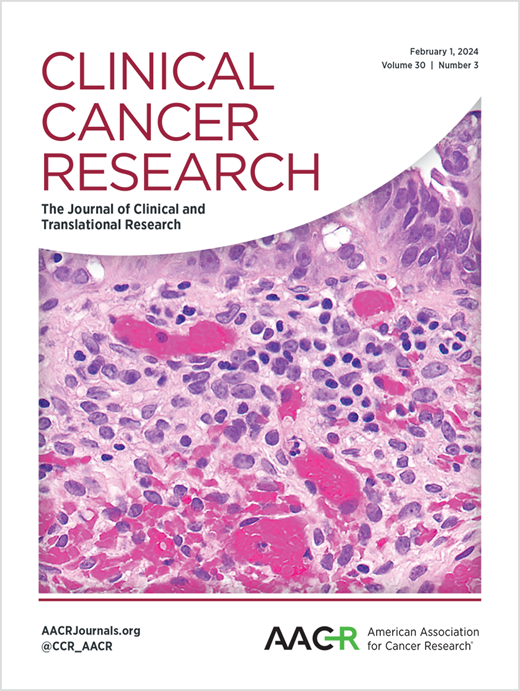早期ctDNA动态为广泛期小细胞肺癌患者的一线治疗提供信息。
IF 10.2
1区 医学
Q1 ONCOLOGY
引用次数: 0
摘要
小细胞肺癌(SCLC)是一种侵袭性恶性肿瘤,预后较差,尽管最初的治疗效果良好。本研究评估循环肿瘤DNA (ctDNA)用于监测疾病和评估一线治疗对大分期SCLC (1L ES-SCLC)患者的疗效。在TAZMAN试验中,31例1L ES-SCLC患者接受了durvalumab和依托泊苷加卡铂或顺铂的标准治疗。我们分析了来自27/31例患者的228份血浆样本,使用液体活检方法检测体细胞突变和拷贝数畸变,同时也考虑了克隆造血(CH)突变。结果基线ctDNA分析在96.3%的患者中检测到体细胞改变,主要是TP53和RB1等基因。早期治疗期间的ctDNA动态显示变异等位基因频率(VAF)显著降低,证实了早期但短暂的化学敏感性。在诱导过程中,ctDNA低于检测极限的减少预测了治疗持续时间较长的患者,在区分这些患者方面超过了影像学。在常规影像学检查之前,ctDNA的变化往往预示着疾病的复发,这表明ctDNA是一个更敏感的治疗疗效指标。结论早期ctDNA动态可以为1L ES-SCLC的治疗效果和潜在的分子复发提供有价值的见解。ctDNA可以加强治疗监测,并可能指导无效治疗的停止。为了充分了解ctDNA在SCLC管理中的潜力,从诊断到治疗和复发监测,需要更大规模的扩展NGS研究。本文章由计算机程序翻译,如有差异,请以英文原文为准。
Early ctDNA dynamics inform first-line therapy in patients with extensive-stage small cell lung cancer.
PURPOSE
Small cell lung cancer (SCLC) is an aggressive malignancy with a poor prognosis, despite initial treatment responses. This study evaluates circulating tumour DNA (ctDNA) for monitoring disease and assessing the efficacy of first-line therapy in patients with extensive-stage SCLC (1L ES-SCLC).
EXPERIMENTAL DESIGN
In the TAZMAN trial, 31 patients with 1L ES-SCLC received standard treatment with durvalumab and etoposide, plus carboplatin or cisplatin. We analysed 228 plasma samples from 27/31 patients using a liquid biopsy approach to detect somatic mutations and copy number aberrations, while also accounting for clonal haematopoiesis (CH) mutations.
RESULTS
Baseline ctDNA analysis detected somatic alterations in 96.3% of patients, primarily in genes like TP53 and RB1. ctDNA dynamics during early treatment showed significant reductions in variant allele frequency (VAF), confirming early but short-lived chemosensitivity. Reduction of ctDNA below the limit of detection of the assay during induction predicted patients with longer treatment duration, surpassing imaging in distinguishing these patients. ctDNA changes often anticipated disease relapse before conventional imaging, suggesting ctDNA as a more sensitive treatment efficacy marker.
CONCLUSION
The study shows that early ctDNA dynamics can provide valuable insights into treatment efficacy and potential molecular relapse in 1L ES-SCLC. ctDNA can enhance treatment monitoring and potentially guide the discontinuation of ineffective therapies. Larger studies with extended NGS panels are needed to fully understand the potential of ctDNA in SCLC management, from diagnosis to treatment and recurrence surveillance.
求助全文
通过发布文献求助,成功后即可免费获取论文全文。
去求助
来源期刊

Clinical Cancer Research
医学-肿瘤学
CiteScore
20.10
自引率
1.70%
发文量
1207
审稿时长
2.1 months
期刊介绍:
Clinical Cancer Research is a journal focusing on groundbreaking research in cancer, specifically in the areas where the laboratory and the clinic intersect. Our primary interest lies in clinical trials that investigate novel treatments, accompanied by research on pharmacology, molecular alterations, and biomarkers that can predict response or resistance to these treatments. Furthermore, we prioritize laboratory and animal studies that explore new drugs and targeted agents with the potential to advance to clinical trials. We also encourage research on targetable mechanisms of cancer development, progression, and metastasis.
 求助内容:
求助内容: 应助结果提醒方式:
应助结果提醒方式:


